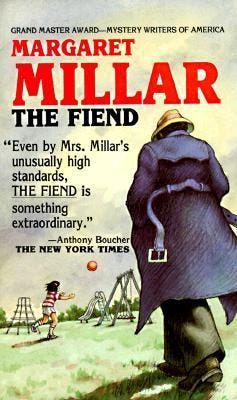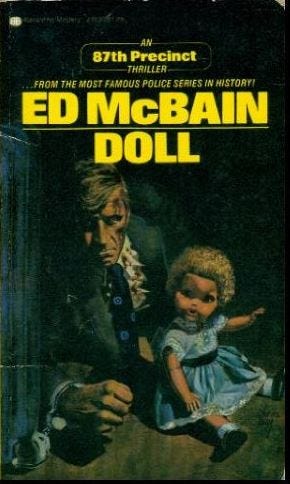C&C 3: The Shady Side of the Sixties, Part Two
Volume 2 of Library of America’s ‘60s crime fiction collection
On to Library of America’s Crime Novels: Four Classic Thrillers 1964-1969, coming in September 2023. Here’s my overview of volume one, covering 1961 to 1964, ’64 apparently being one hell of a year.
Whenever I read Margaret Millar, I’m reminded I haven’t read her enough. That feeling came through again after finishing The Fiend (1964), a harrowing example of her specialty, domestic suspense. It depicts the friendship between two nine-year-olds, charged with childlike curiosity and callousness, and also tracks the man with a troubled history who, unknown to anyone, has taken an intense interest in the girls. Their interactions implicate multiple parties—parents, neighbors, siblings, lovers—and expose fault lines lying dormant under relationships. Millar’s suitably neat-as-a-pin prose recounts the collapse of more than one well-tended Southern California house of cards. By this time this heartbreaker ends, you’re not sure if a crime has been committed, but you do know that everyone is guilty.
Any excuse to return to Ed McBain’s 87th Precinct is worth taking. Over four dozen novels chronicle the lives and cases of Isola’s Finest, but as with all effective procedurals you can dive in anywhere. Even by McBain’s (aka Evan Hunter’s) standards, Doll (1965), the twentieth in the Precinct series, is a white-knuckle trip. Detective Steve Carella asks a grieving, on-the-ropes Bert Kling to partner with him investigating the murder of a fashion model, a decision with fateful consequences for both. It boasts a devious structure and McBain’s effortless prose, capable of moments of grace, as when Detective Meyer Meyer visits a crime scene (“There are different silences in an empty apartment, and if you are a working policeman, you do not scoff at poetic fallacy”) and hard-won big-city pragmatism.
The way Byrnes figured it, psychology was certainly an important factor in police work because it helped you to recognize that there were no longer any villains in the world, there were only disturbed people. Psychology substituted understanding for condemnation. It was a very nice tool to possess, psychology was, until a cheap thief kicked you in the groin one night. It then became somewhat difficult to imagine the thief as a put-upon soul who’d had a shabby childhood.
Chester Himes makes a return LOA engagement. The Real Cool Killers (1959), one of his Harlem-set novels featuring NYPD detectives Coffin Ed Johnson and Grave Digger Jones, appeared in the 1950s collection. As editor Geoffrey O’Brien notes in his introduction, Run Man Run (1966) was inspired by Himes’s real-life encounter with a drunken police officer while working overnight at a Horn & Hardart automat. Himes spins this event into a taut Manhattan manhunt, the sole survivor of a bloodbath desperate to convince anyone, even his own girlfriend, that a paranoid, boozed-up White cop opened fire on three Black men. The strongest chapter comes before the chase begins, as workers of different races and classes arrive at the automat, a setting richly evoked by Himes. They bicker and gripe, unaware of the horror they’re about to discover. Once they do, an entirely new set of workers comes on the scene, because in America the wheel has to keep turning. “By eleven A.M. the murder had been expertized, efficiently, unemotionally, thoroughly, and as far as was discernible the slight pinprick on the skin of the city had closed and congealed.”
Patricia Highsmith’s The Tremor of Forgery (1969) is more akin to the work of Paul Bowles or Albert Camus than her crime fiction confreres and was received accordingly; the author later declared it her own favorite of her books. New York scribe Howard Ingham journeys to Tunisia to work on a film project. When his collaborators fail to turn up, he begins to lose his bearings, with only a loose community of oddball expats and his trusty typewriter to anchor him. That tool of his trade becomes a literal weapon in what may or may not be a murder; in the desert heat, it’s so difficult to be certain of these things. Anna von Planta, editor of Patricia Highsmith: Her Diaries and Notebooks, wrote that Highsmith recorded “her at times derogatory impressions of North Africa in a travelogue for the New Statesman” as well as Forgery. Here’s a diary entry dated July 7, 1966, with Highsmith commenting on people she’d asked for help in the Tunisian town of Hammamet, a location in Forgery:
All have let us down here. They take names and telephone numbers, make promises, and do not follow through. It must be a curious god they have.
Forgery is a troubling book; Highsmith, in her usual deeply internal style, puts the reader in too-close proximity to Ingham’s wounded psyche, not always a comfortable place to be. For that reason, it’s also a haunting book, and a fitting note on which to close the collection.
What I’m Watching
Blackberry (2023). If the product biopic is now a genre—and Air, Flamin’ Hot, and Tetris would indicate that it is—then Blackberry is the class of the lot. Why? Because the product ultimately failed, which makes for a far more interesting story. Jay Baruchel and It’s Always Sunny in Philadelphia’s Glenn Howerton, two strong comic actors almost unrecognizable here, duet well as the gawky tech genius and the take-no-prisoners businessman who inflicted smartphones on us. Featuring enough hubris to supercharge a Greek tragedy and, seeing that the downfall is partly triggered by an attempt to buy a hockey team, also a Canadian tragedy.
What I’m Drinking
I bought a bottle of the Brazilian sugarcane spirit cachaça for the same reason everybody does, to make caipirinhas. But I hate being a one-dimensional imbiber, so I started casting around for another use for it. Meet the Rabo de Galo, which means rooster tail—get it?—in Portuguese. Introduced in the mid-1950s when vermouth maker Cinzano came to Brazil, it has quickly become a summer staple at Chez K.
1 ¾ oz. cachaça
¾ oz. sweet vermouth
½ oz. Cynar
2 dashes orange bitters
Stir. Strain into a rocks glass with ice. Garnish with an orange twist.









Okay, you win - I ordered a used copy of Doll just based on that cover! By the way, as a comic fan I have to ask - have you ever read any of Ed Brubaker's Criminal or Reckless graphic novels? You'll never find a better comic writer of noir!
Interesting descriptions for both LOA titles. If you were going to recommend one of these volumes to a new reader of the genre, which would it be?